If you have to board a plane just past midnight to arrive at your destination double digit hours later at a destination with a huge time difference, what better place to regain your stamina and equilibrium then to move into an atmosphere that is almost too luxurious to describe. Nothing beats the grand and always getting grander Mandarin Oriental in Bangkok.
Entering the lobby where the door man immediately and continuously greeted me by name and where the elevator man remembered my floor number the entire time, viewing the most amazing 10 foot. Not only is there a bang in Bangkok, luxury tracks to Laos and the gentle smiling people but the City of Angels and the Country of Smiles is great for connecting the posh travel dots.
By Barbara Kingstone
Bangkok was the departure city for my longed for dream voyage on the Eastern & Oriental Train. Although I’ve been to the City of Angels several times, it’s still impressive to visit the 16th century Wat Po, the oldest and biggest temple and Wat Phra Kaew where the attraction is the Emerald Buddha and if given the opportunity, a stay at the Mandarin Oriental Hotel.
Bangkok is always steamy, hot and smoggy but there are air con cabs, if walking takes the fun out of sightseeing. But hot air or smog, one has to experience a ride in one of the colorful tuk tuks,( a covered bike with muscular leg power) usually pedaled by an enthusiastic driver who tries his English vocabulary while I say my few words in Thai.
 There’s no question that the new Skytrain has made a noticeable difference in traffic and the gridlocks is somewhat eased. But in a city of 10 million people, and counting, even the cleverly planned overhead highway hasn’t completely abolished the bumper to bumper jams.
There’s no question that the new Skytrain has made a noticeable difference in traffic and the gridlocks is somewhat eased. But in a city of 10 million people, and counting, even the cleverly planned overhead highway hasn’t completely abolished the bumper to bumper jams.
But truth be told, my attempt at sightseeing wasn’t a priority on my ‘bucket list’. My lengthy double digit hour flight was that I was one of the lucky 108 passengers on the maiden Eastern & Oriental Train voyage to Laos. Uber luxury on narrow tracks, (1 metre wide) known for outstanding service with an itinerary that was a ‘grabber’.
N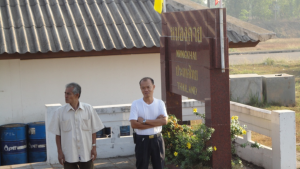 o sooner had I left the limo at Bangkok’s Hualampong Station, than my luggage was whisked away not to be seen until I entered my cabin, N2. Getting to the station’s lounge was a curious affair as I passed a row of barbers, one next to the other, cropping and cutting men’s hair -stool, apron, clippers, gel and brush. It was business as usual for the Thais.
o sooner had I left the limo at Bangkok’s Hualampong Station, than my luggage was whisked away not to be seen until I entered my cabin, N2. Getting to the station’s lounge was a curious affair as I passed a row of barbers, one next to the other, cropping and cutting men’s hair -stool, apron, clippers, gel and brush. It was business as usual for the Thais.
I was escorted into a large station lounge where the guests were waiting. This being a first of the soon to be regular luxury voyage between Singapore, Bangkok (where I boarded the train) to Laos proved extremely popular especially for the railway buffs who had been on various Orient Express trips. The demand was so overwhelming that two extra cars were added to maximum 22 carriages.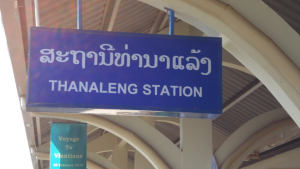
After handing over my passport to the receptionist, I soon learned that all formalities like visas needed for other countries ( in this case Laos) are handled by the company . Already this trip seemed like a no- brainer, a hands off, fun and fancy free event.
The Eastern & Oriental Express was debuting its four day three night maiden journey. Our trip took us through the northeastern region of Thailand via the Friendship Bridge on the Mekong River into Vientiane, Laos’s capital city. I can now tick off another on my ‘bucket’ list.
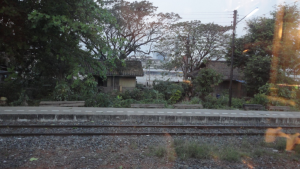 S
S
ince Bangkok’s station is near Chinatown, as the train left the City of Angels, the small alleys and lanes, the overcrowded conditions of that area – a melting pot of nationalities- were visible. The squat wood small Thai wood houses were deteriorating. The new skyline that doesn’t resemble the Bangkok I recall. High office buildings and huge glass shopping malls seemed to have overtaken the city’s outline.
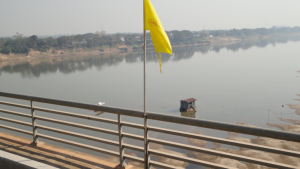 Although this trip to cross the Mekong River was actually for four days and three nights, returning back to Thailand the day of the Ribbon cutting , I decided to stay on in Laos to see Vientiane, the capital and Luang Prabang, both lovely small, charming friendly cities filled with rusty bikes and motorcycles that whiz by making New York City seem like easy street crossing. However, this meant forfeiting the extra day and night on board. Ah, the choices one has to make!
Although this trip to cross the Mekong River was actually for four days and three nights, returning back to Thailand the day of the Ribbon cutting , I decided to stay on in Laos to see Vientiane, the capital and Luang Prabang, both lovely small, charming friendly cities filled with rusty bikes and motorcycles that whiz by making New York City seem like easy street crossing. However, this meant forfeiting the extra day and night on board. Ah, the choices one has to make!
I saw this as a Tale of Two Cities. The distance between Bangkok and Vientiane is really just a few hours by car but the train’s itinerary included interesting diversions. Firstly there was a palm reader in the train’s Library who didn’t flinch when she pointed out my long life line and two parallel lines. “Ah, this one is for receiving money and the longer one is for money going out.” Well, there was no denying it she could see right through me leaving me time to rush to the small but well equipped on-board shop on my way to hear the renowned author William Warren. Warren is a friend and the definitive biographer of the late Jim Thompson, one of the original Thai silk magnates who to this day, has puzzled sleuths with his still unsolved mysterious disappearance and demise.
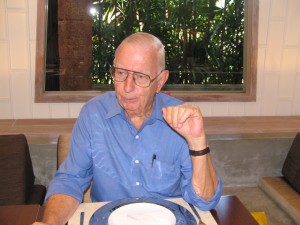 Georgia born Warren, has lived in Bangkok for over 4 decades and seems to have met every celebrity and dignitary who has passed through or lives in the area.
Georgia born Warren, has lived in Bangkok for over 4 decades and seems to have met every celebrity and dignitary who has passed through or lives in the area.
With a large group who had gathered in the Observatory Bar , it was great fun it was to listen to his charming, chatty, funny, informal talk about his life in Thailand. The smooth talking southerner still has that drawl and charm and kept us captivated for over an hour.
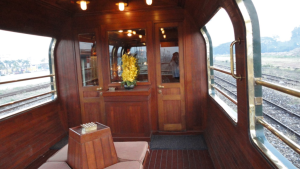 The Pullman Cabin which became my ‘room’ for the next three days and two nights was small but certainly comfortable for a single person. But at first glance, I couldn’t imagine where I was to put all my toiletries and clothing. The compartment steward, available 24 hours a day, introduced me to the various hidden drawers and racks. Soon my clothing was hanging or folded and my toiletries were supported by barred racks. A walk-in shower, basin, dressing gown, fluffy towels and toiletries were neatly and conveniently placed in the air conditioned cabin. Everything had been well thought out. Here’s where the old adage, a place for everything and everything in its place, really applied.
The Pullman Cabin which became my ‘room’ for the next three days and two nights was small but certainly comfortable for a single person. But at first glance, I couldn’t imagine where I was to put all my toiletries and clothing. The compartment steward, available 24 hours a day, introduced me to the various hidden drawers and racks. Soon my clothing was hanging or folded and my toiletries were supported by barred racks. A walk-in shower, basin, dressing gown, fluffy towels and toiletries were neatly and conveniently placed in the air conditioned cabin. Everything had been well thought out. Here’s where the old adage, a place for everything and everything in its place, really applied.
A reading light, window blinds perfectly fitted so that no light could get through during the occasional night stops and the clever day to night transformation when the smartly upholstered sofa was covered at night with a white starched, smooth sheet and spanking clean coverlets. And since there is no laundry or ironing services on board, any creases were either not noticed or in the heat of the day, increased or disappeared. However, I did pass a few cabins where I actually saw some guests with iron in hand and an ironing board sticking out into the doorway. I still can’t imagine why.
The heavier luggage for those on a longer trip, was stored in another car and guests were told to bring only the necessities in a soft sided bag. Tradition continues on the Eastern & Oriental Express and dressing for dinner was expected as were chic casual light weight clothing during the day. Truth be told, we always take more than we need and this was a perfect example of learning to dress out of a small convenient bag.
Obviously, this was also an important tour for others since I counted over a dozen languages- Russian, Hebrew, Polish, English, (is Gaelic considered a language?), French, German, Italian , Spanish) Czech, Japanese and Chinese, Pilipino and heavily accented Australian (is that considered English?).
Since my accommodations were at the end of the train and the three restaurants, Malaya, Rosaline, and Saloon, were towards the centre really closer to the other end, I learned very quickly on these narrow bumpy tracks, to move quickly when the train slowed and run like an Olympian when it stopped to fill up the water supply. Until I found my train legs, I just bounced from side to side, clinging to the various hand rails. The only real difficult issue was the location of my cabin since out of the 22 cars, I figured I was in the 20th. Silhouette heels are not suggested.
To accommodate everyone, each person had to decide which meal seating they would prefer. My choice, the earliest at 6.45 while the later was 9.30PM. (Lunch started at 11.30 the next at 1.30).Then we were assigned one of the three different restaurant for each meal to get the feel of the different décor. Each is decorated as one would expect, differently but all with exquisite wood inlay and craftsmanship not seen any longer. My favorite dining car, the cozy Saloon, has a traditional Chinese feeling with its dark rosewood and deluxe plush seat covering.
The stainless steel bodied carriages built in 1971, were brought in 1991 to the expert workshops in Singapore where the interiors were magically remodelled. The inspiration for the interior design came from the 1930’s movie classic, Shanghai Express, starring Marlene Dietrich. The marquetry panels on the interior walls are made of elm, cherry, teak, and rosewood- all hand cut by local craftsmen. The compartments also panelled, are in precious cherry wood and elm burr. Intricate trimmings throughout the train and the medallion in my cabin, as I assumed were all others, was extraordinary. The use of colour like the pale ash wood in the Bar Car and the darker Burmese teak floor in the Observation car are so reminiscent of a time long past.
Not only is the wood an attribute to this luxurious surrounding but so too are the fine china, crystal and flatware and meals that were photo perfectly served. There was no death on this Orient Express, (How could one write about the train and not throw in that phrase?) only moans and groans of happiness. Needless to add, the food was outstanding. The varied items on each menu could please anyone. From tradition spicy sour soup to beef, chicken and fish offerings and lemongrass infused recipes plus rice and noodles and an abundance of local and often strange but delicious fruits.
After a somewhat bouncy two nights and little sleep due to the narrow tracks, (1 metre wide), the train and I did pitch about. But the positive side is that with a press of a button, my valet brought my early breakfasts served on a silver tray with the best croissants this side of Paris. At an insanely early hour, (about 6AM) I seemed to have the train to myself. My exercise was running to the far end outdoor Observation car where I wanted to feel the early morning cool and see the locals off to work or school along with the ever changing landscape. And the extra waking hours gave me time to see the very red sun rise .
The itinerary included an excursion to a World Heritage Site, the 11th century Phimai (Pimai) Historical Park, one of the most important Khmer ruins and monuments in Thailand. It has been said Prasat Hin Phimai may have influenced the design of the later Angkor Wat in Cambodia. School children surrounded me to see my clothing, shyly speak some English and asked for someone to take a photo of all of us, insisting that I be included. Giggling teenagers seems to be international.
Our next stop was to be to a vineyard but with the addition of the extra cars, the engine grunted, jerked and finally gave out and a more powerful locomotive was attached a few hours later. As the sun set the group was divided into two. One bus went to Khao Yai vineyard while my group’s wine tasting was at the family owned Granmonte Estate (in Asoke Valley) where the outdoor tables had nibbles of cheese, crackers and sausages. The red Cabernet was unexpectedly tasty. The white wines were not.
Certainly the big day was when we crossed the Friendship Bridge over the Mekong River into Laos with the many welcoming signs and fluttering flags. It seems so outdated but this is still a Communist country and next to their nation’s flag of red, blue with a white disc and another band of red, there’s the sickle and hammer banner. When we came to a complete stop, awaiting us were dozens of dignitaries from both countries and, of course, there was the very official Ribbon Cutting ceremony. It was a bit of history which I wouldn’t have wanted to miss.
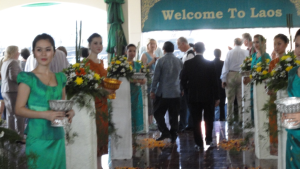 A green carpet with floral petals, strewn by nubile young Laotians woman in wonderful local silk finery greeted the train load as two muscular drummers heartily beat us into Thanalaeng, the Laotians station. This important milestone was a much looked for opportunity for Laos, a land locked and poor country. The hope that tourism would aid their unemployment and poverty was cause for the celebration. Obviously more visitors to this poor but exquisite country, would be most a welcomed blessing.
A green carpet with floral petals, strewn by nubile young Laotians woman in wonderful local silk finery greeted the train load as two muscular drummers heartily beat us into Thanalaeng, the Laotians station. This important milestone was a much looked for opportunity for Laos, a land locked and poor country. The hope that tourism would aid their unemployment and poverty was cause for the celebration. Obviously more visitors to this poor but exquisite country, would be most a welcomed blessing.
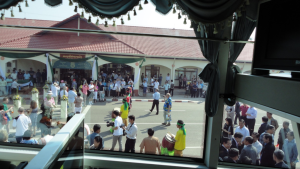 The official ribbon cutting done the various high officials waved and stayed long enough until we were all on the waiting buses to take us for a city tour of Vientiane, the capital city. And it was at the 25 room Settha Palace Hotel where a marvelous Laotian buffet lunch was hosted by the gracious Thomas Pillai, general manager of this charming French Colonial boutique hotel.
The official ribbon cutting done the various high officials waved and stayed long enough until we were all on the waiting buses to take us for a city tour of Vientiane, the capital city. And it was at the 25 room Settha Palace Hotel where a marvelous Laotian buffet lunch was hosted by the gracious Thomas Pillai, general manager of this charming French Colonial boutique hotel.
MFor those returning to Bangkok, it was back to the train for another night while I decided, as did a few others, to stay in Laos. The newly renovated, Setttha Palace Hotel with ceiling fans, spacious lobby with shiny marble floors and period furniture, served a wonderful spread of international and Laotian food.
Since I was staying overnight before going to the more sophisticated Luang Prabang, I was somewhat disappointed not to be staying longer as my large room overlooked a lush blooming garden and pool. Next morning I was off by plane to the south where I again was surprised by the 5 star, La Residence Phou Vao resort-style hotel on the edge of the city. Everything from the floral arrangements to the indoor/outdoor terrace facing the Infinity pool and my large and perfectly decorated suite was certainly unexpected in this isolated part of the world. Overseen by the seemingly ever present general manager, Philippe Bissig, La Residence Phou Vao had enough activities including a new spa which could keep a guest busy, but there are so many sights to see and many magnificent wats (temple/monasteries) and silk making establishments.
The night market stretching the entire length of the main street, is a great draw with some truly fine crafts. After my solo dinner at L’Elephant, considered one of the better restaurants in the town, while on my way to the market, I saw a somewhat out of place deluxe house ware shop selling wonderful silk bedspreads, pillow cases, shawls, ebony ware. Sandra, shop keeper of Caruso ,is from Montreal and the city where I grew up. So we were soon discussing people we both knew. Being so far from home certainly made the world feel very small. Between the amazing train trip from the City of Angels to the country of ‘smiling people’, I finally felt very native, laid back and easy going. I learned the wonderful description of the Laotians which was the perfect description.. “They are the least urgent people in the world.”


